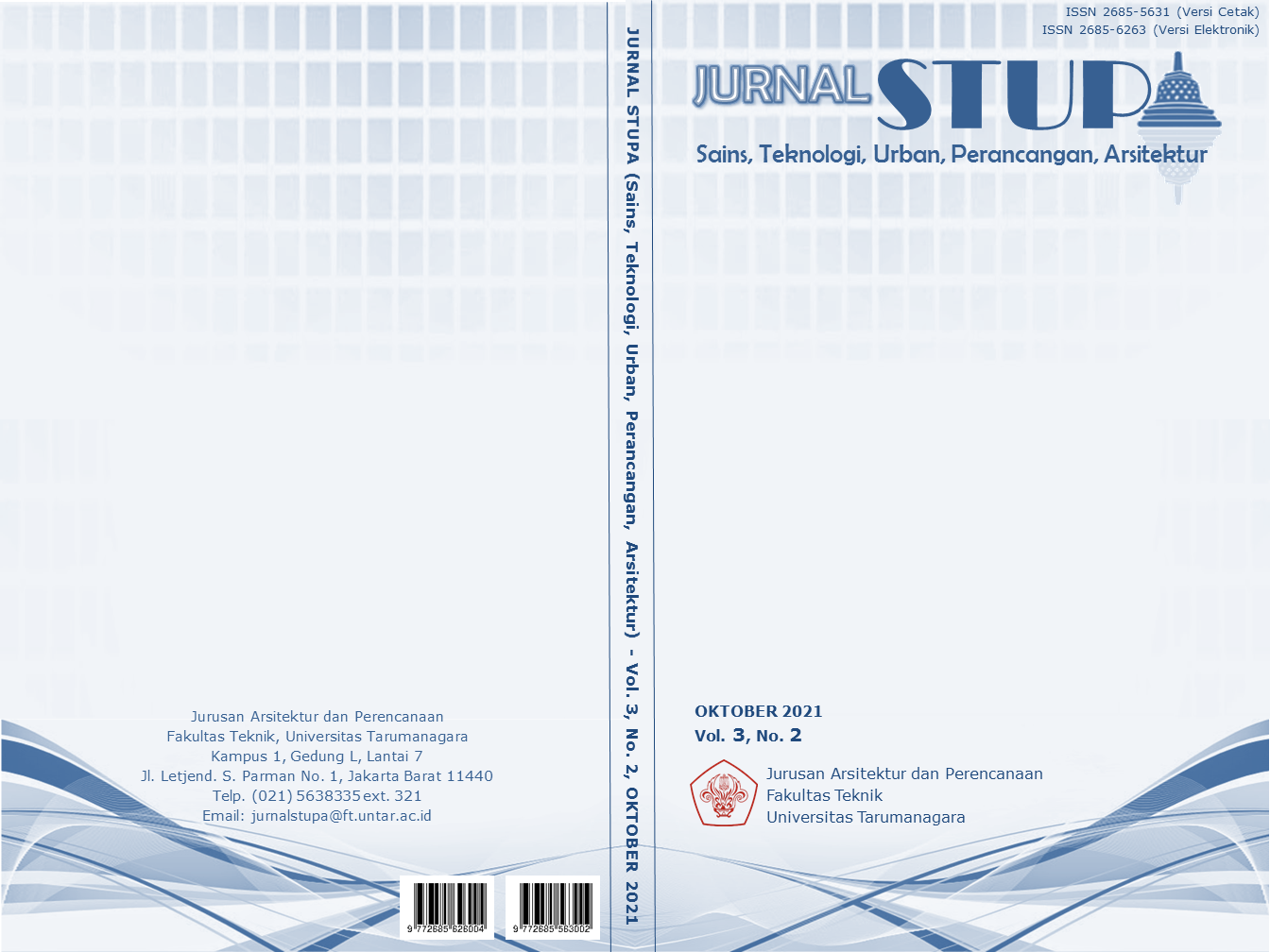SEAWEED CHRONICLE: SEBUAH PROYEK HIBRIDA ESTETIKA & INDUSTRI RUMPUT LAUT DI PULAU PARI, KEPULAUAN SERIBU, INDONESIA
Main Article Content
Abstract
As an area close to Indonesia’s capital city, Thousand Island have both nature and human ecosystem problems. From a nature perspective, the high levels of carbon produced by human activities in the capital cause marine pollution and imbalance of the Java Sea ecosystem. Meanwhile, from a human perspective, the high dependence of the people of the Thousand Islands on the capital city to meet their daily needs has made it difficult for the quality of life and the local economy to develop. In addition, the Thousand Islands has potential to grow seaweed, but didn’t catch local people’s interest because of the low selling value due to a lack of knowledge on how to process seaweed properly. The author designed the ‘Seaweed Chronicle : An Industrial and Aesthetic Hybrid Project’ which aims to solve the problems of the Thousand Islands, especially Pari Island, with the principles of ecological architecture. The industrial program utilizes an abundance of seaweed commodities to be processed into daily necessities for the community to improve the quality of life. The application of the theme 'beyond ecology' in the form of a program to appreciate the aesthetics of seaweed, which aims to change the human perspective to appreciate and appreciate the existence of other creatures (not just objects that are enslaved, but as subjects that are equal to humans) so as to increase awareness of nature. The program details for the project are industrial workshops (processing seaweed into paper, plastics, fertilizers, building materials, and furniture), seaweed development galleries (consisting of painting galleries, aquariums, seaweed appreciation with light, sea waves, time travel, and reflection), restaurants, educational stages, and stalls selling seaweed products. The project can be enjoyed by the people of Pari Island as well as attracting tourists.
Keywords: aesthetic; ecology architecture; industry; seaweed
Abstrak
Sebagai daerah yang berdekatan dengan ibukota Jakarta, Kepulauan Seribu memiliki permasalahan ekosistem alam dan manusia. Dari segi alam, tingginya kadar karbon akibat aktivitas manusia di ibukota menyebabkan pencemaran laut dan rusaknya keseimbangan ekosistem Laut Jawa. Sedangkan dari segi manusia, tingginya ketergantungan masyarakat Kepulauan Seribu terhadap ibukota Jakarta untuk memenuhi kebutuhan sehari-hari menyebabkan kualitas kehidupan dan ekonomi setempat sulit berkembang. Selain itu, Kepulauan Seribu memiliki potensi budidaya rumput laut, namun kurang diminati masyarakat karena nilai jual rendah akibat kurangnya pengetahuan cara mengolah rumput laut. Penulis merancang proyek ‘Seaweed Chronicle : Sebuah Proyek Hibrida Estetika & Industri Rumput Laut’ yang bertujuan menyelesaikan permasalahan Kepulauan Seribu, khususnya Pulau Pari, dengan prinsip arsitektur ekologi dan menyatukan fungsi estetika dan industri. Program industri memanfaatkan komoditas rumput laut yang melimpah untuk diolah menjadi barang kebutuhan sehari-hari masyarakat guna meningkatkan kualitas hidup. Penerapan tema ‘beyond ecology’ berupa program penghayatan estetika rumput laut yang bertujuan mengganti cara pandang manusia agar lebih menghayati dan menghargai keberadaan makhluk lain (bukan hanya sekedar objek yang diperbudak, namun sebagai subjek yang setara dengan manusia) sehingga meningkatkan kepedulian terhadap alam. Rincian program pada proyek adalah workshop industri (pengolahan rumput laut menjadi kertas, plastik, pupuk, material bangunan, dan furniture), galeri penghayatan rumput laut (terdiri dari galeri lukisan, aquarium, penghayatan rumput laut dengan cahaya, gelombang laut, perjalanan waktu, dan refleksi), restoran, panggung edukasi, dan kios penjualan hasil rumput laut. Proyek dapat dinikmati oleh masyarakat Pulau Pari sekaligus menarik wisatawan.
Article Details
Section
References
Chung, I. K., Oak, J. H., Lee, J. A., Shin, J. A., Kim, J. G., & Park, K.-S. (2013). Installing Kelp Forests/Seaweed Beds for Mitigation and Adaptation Against Global Warming: Korean Project Overview. ICES Journal of Marine Science, 1038–1044.
Dahuri, R. (2005). Potensi Ekonomi Kelautan. Republika.
Damarjati, D. (2019). Kunci BBM dan Bahan Pokok Satu Harga di Kepulauan Seribu. news.detik.com.
Dove, C. A. (2014). The Development of Unfired Earth Bricks Using Seaweed Biopolymers . WIT Transactions on Ecology on The Built Environment, Vol 142, 219-230.
Frick, H. (2006). Arsitektur Ekologis. Yogyakarta: Kanisius.
Gewati, M. (2019). Begini Cara Kepulauan Seribu Jadi Produsen Rumput Laut Kelas Dunia. Kompas.com.
Iselin, J. (2019). The Curious World of Seaweed. California: Heyday Books.
Jamaluddin, Syam, H., Mustarin, A., & Rivai, A. A. (2020). Spatial Multi-Criteria Approach For Determining The Cultivation Location Of Seaweed Eucheuma Cottonii in Takalar Regency, South Sulawesi, Indonesia. Aquaculture, Aquarium, Conservation & Legislation - International Journal of the Bioflux Society., 1413-1430.
Larsen, K. (2018). Seaweed Thatch Reimagined. Guldbergsgade: Kobenhavns Erhvervsakademi.
NiputuDK. (2015). Budidaya Rumput Laut Dengan Metode Apung Standar Better Management Practices (BMP). Medan.
N'Yeurt, A. d., Chynoweth, D. P., Capron, M. E., Stewart, J., & Hasan, M. A. (2012). Negative Carbon Via Ocean Afforestation. Process Safety and Environmental Protection, 467-474.
Parsons, M. J. (1987). How We Understand Art: A Cognitive Developmental Account of Aesthetic Experience. New York: Cambridge University Press.
Putri, G. R. (2019). Karakterisasi Bioplastik dari Rumput Laut (Eucheuma cottonii). Risenologi (Jurnal Sains, Teknologi, Sosial, Pendidikan, dan Bahasa) Volume 4 Issue 2, 59-64.
Rositasari, R., Rachma, P., Nurhati, I. S., Purbonegoro, T., & Yogaswara, D. (2017). 5 Dekade LIPI di Teluk Jakarta. Jakarta: Lembaga Ilmu Pengetahuan Indonesia Puslit Oseanografi .
Sedayu, B. B., Erawan, I. M., & Assadad, L. (2014). Pupuk Cair dari Rumput Laut Eucheuma cottonii, Sargassum sp. dan Gracilaria sp. Menggunakan Proses Pengomposan. Jurnal Pascapanen dan Bioteknologi Kelautan dan Perikanan, 61-68.
Siddique, M. N., & Wahid, Z. b. (2017). Effect of mixing proportion on the properties of seaweed modified sustainable concrete. The 2nd International Conference on Applied Science and Technology 2017 (ICAST’17).
Suparmi, & Sahri, A. (2009). Mengenal Potensi Rumput Laut : Kajian Pemanfaatan Sumber Daya Rumput Laut dari Aspek Industri dan Kesehatan. Sultan Agung Vol XLIV No. 118, 96-116.
Wibowo, A. (2019). Rumput Laut, Komoditas Penting Yang Belum Dioptimalkan. Balai Besar Pengujian Penerapan Produk Kelautan dan Perikanan.
You, C. H. (2008). Partnership Opportunity in Developing Pulp & Paper Industry. Seaweed International Business Forum and Exhibition II-Makassar. Jakarta: Departemen Kelautan dan Perikanan.
___(2021). Hasil Sensus Penduduk 2020. Badan Pusat Statistik.
Hoogvliet, N. (2018). Seaweed Re-search . The Hague: Studio Nienke Hoogvliet.

